Juglans nigra
A statuesque tree and lover of disturbed places, if you’ve been to the eastern portion of the United States, you’ve probably encountered black walnut in the wild before.
This native tree loves roadsides, abandoned fields, and the fringes of fragmented forest.
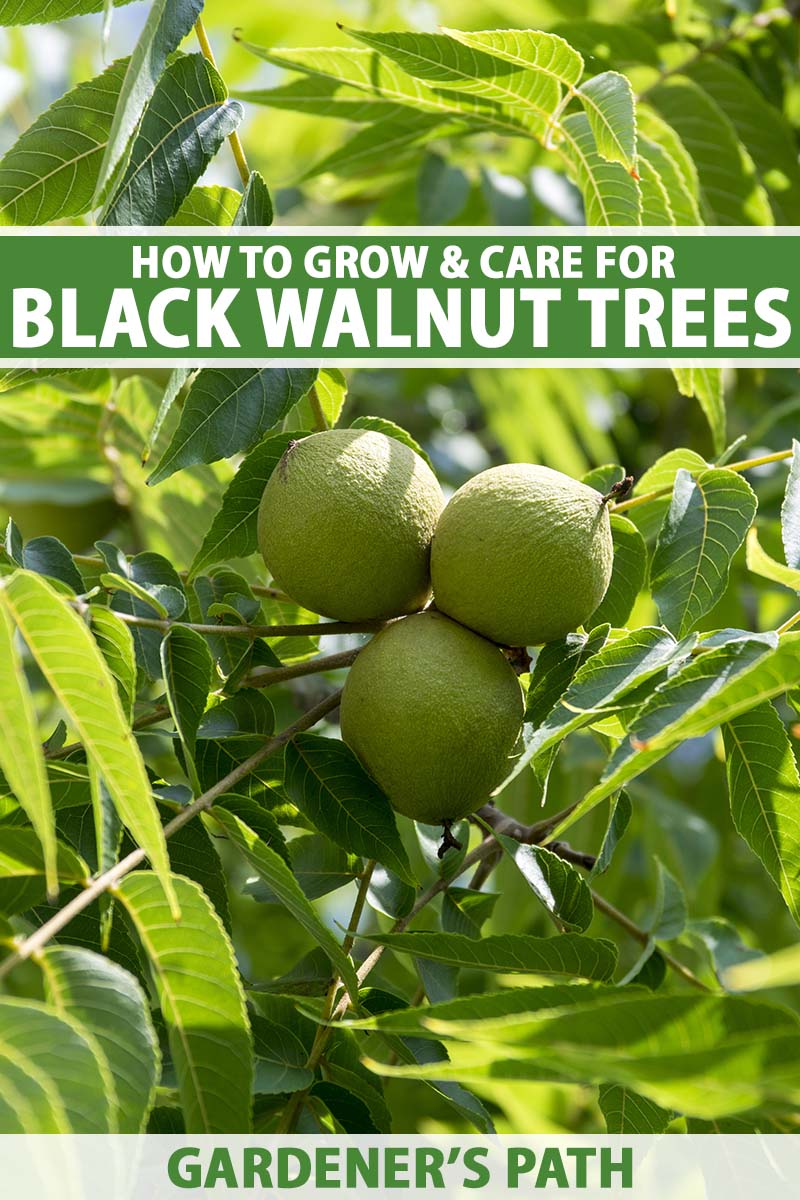
We link to vendors to help you find relevant products. If you buy from one of our links, we may earn a commission.
Come fall when its ponderous green-hulled nuts ripen, the green-yellow foliage often drops first, making it look like a Suessian version of a Christmas tree, festooned with giant baubles.
This characteristic also makes the tree easy to identify, especially when speeding by on the road at 45 miles per hour.
Fortunately, the black walnut’s easygoing nature also makes it a breeze to cultivate at home. Read on to find out how to do just that. Here’s what’s ahead:
What You’ll Learn
What Is Black Walnut?
Black walnut is part of a large nut-producing family that ranges across Europe, Asia, and North, South, and Central America.

Thanks to its nutritious nuts, this tree and its relatives the hickories, butternuts, and pecans, to name just a few, have been disseminated by humans throughout the world.
All members of the walnut genus, Juglans, bear divided leaves and produce an oily nut concealed by a thick rind, to which they owe their name.
Relatively slow growing, black walnut adds about a foot to two feet per year under the right conditions and should produce its first nut crop when it reaches 12 to 15 years old.
Although the tree often sheds leaves and the autumn foliage is nothing to write home about, J. nigra can grow over 100 feet tall, making gorgeous, dappled shade with their diaphanous, fern-like foliage.
Black walnut is also one of the last trees to leaf out in spring.
When planted in full sun, the tree sets low branches and has the ability to grow to be truly monstrous in size.
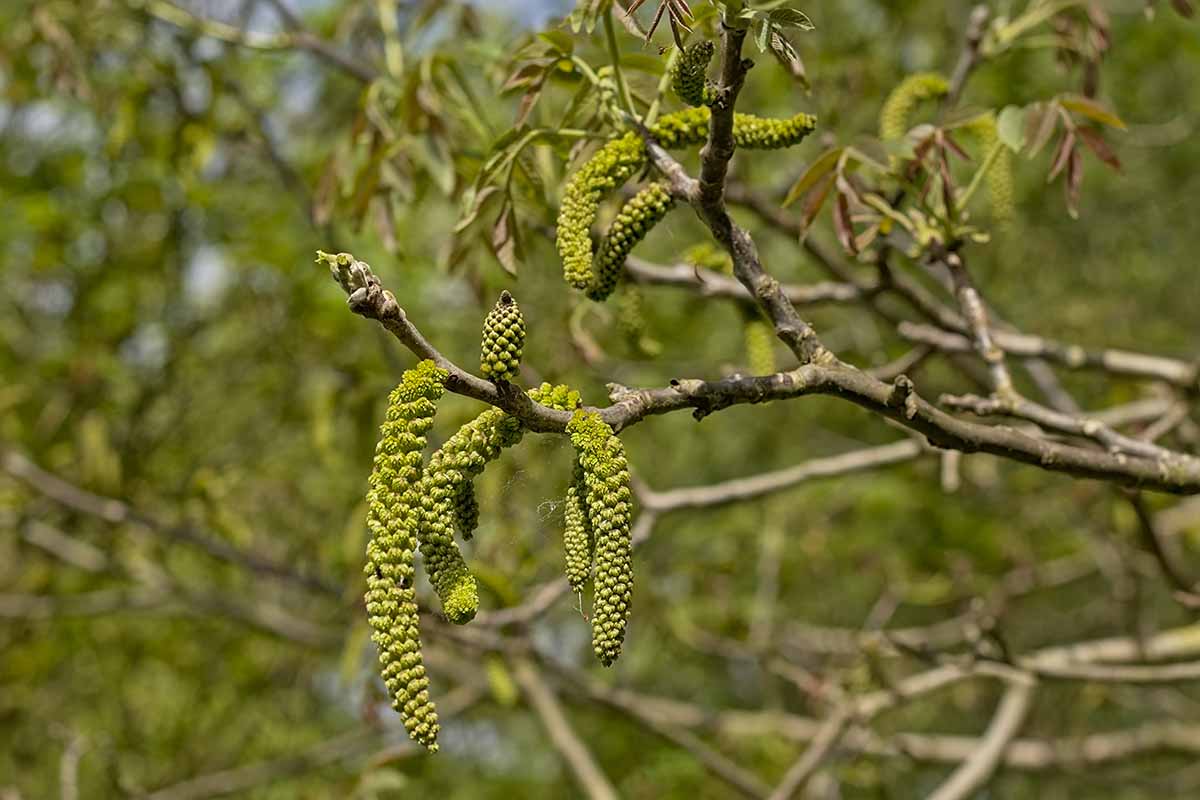
The flowers are wind pollinated, like those of the other members of its genus, and are fairly easy to overlook – unless you’re the type to get excited about green catkins, the male flowers, or the even more inconspicuous clusters of pale green female flowers.
As a monoecious species, both the male and female flowers are present on the same plant.
On the face of it, this resilient, handsome tree seems like a natural choice for the lover of edible plants.
However, black walnut is as reviled as it is revered by gardeners the world over, and is renowned as a truly tricky nut to crack.
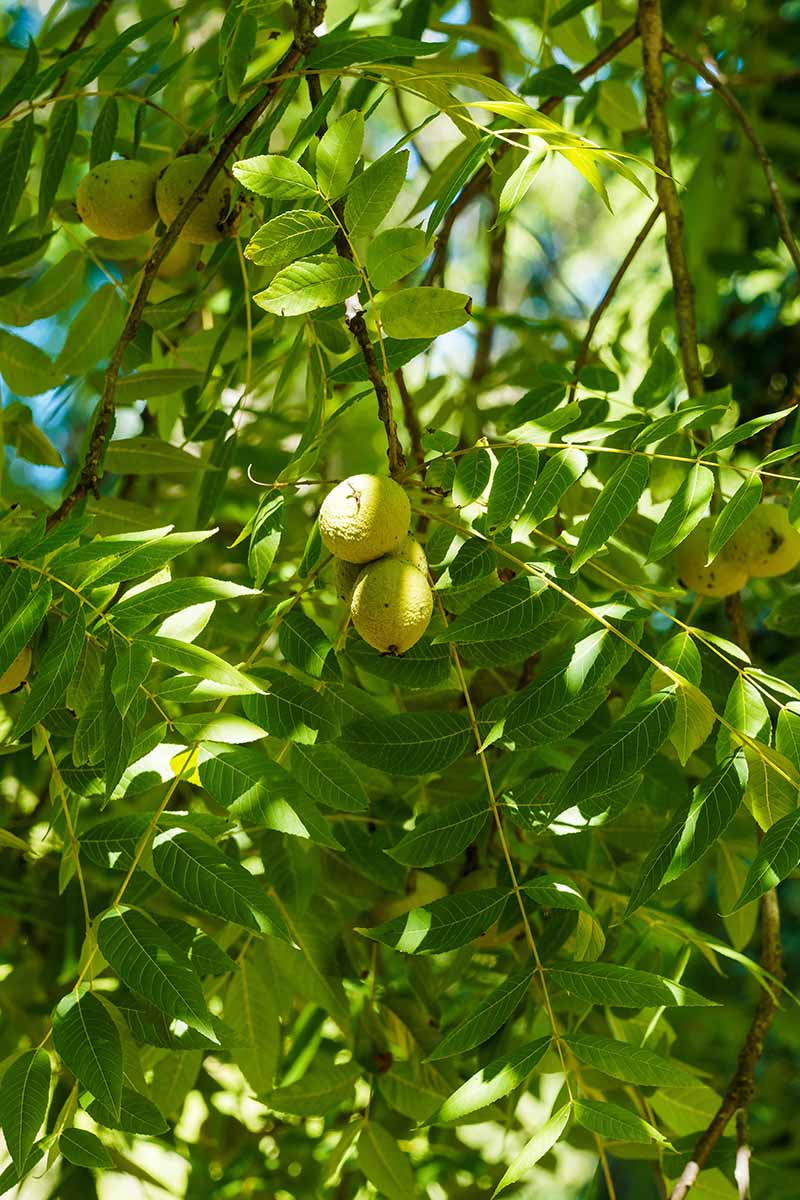
While its timber is valuable and its nuts delicious, J. nigra exudes a toxic chemical called juglone which can inhibit the growth of other plants and cause a blistering rash on exposed skin.
Plenty of plants, including lawn grasses, grow just fine alongside black walnut, but check out this guide for a more complete list. (coming soon!)
Still, this member of the hickory family, Juglandaceae, is native to the United States, cold hardy, tolerant of drought, and pretty easy to grow.
Plus, the nuts, once hulled and cured, are downright delectable.
Cultivation and History
Black walnut has a long and storied history of growing alongside mankind.
When colonists arrived from Europe in the 1600s, the value of this tree in both landscaping and woodworking was quickly discovered and many seedlings were shipped back to the homeland.
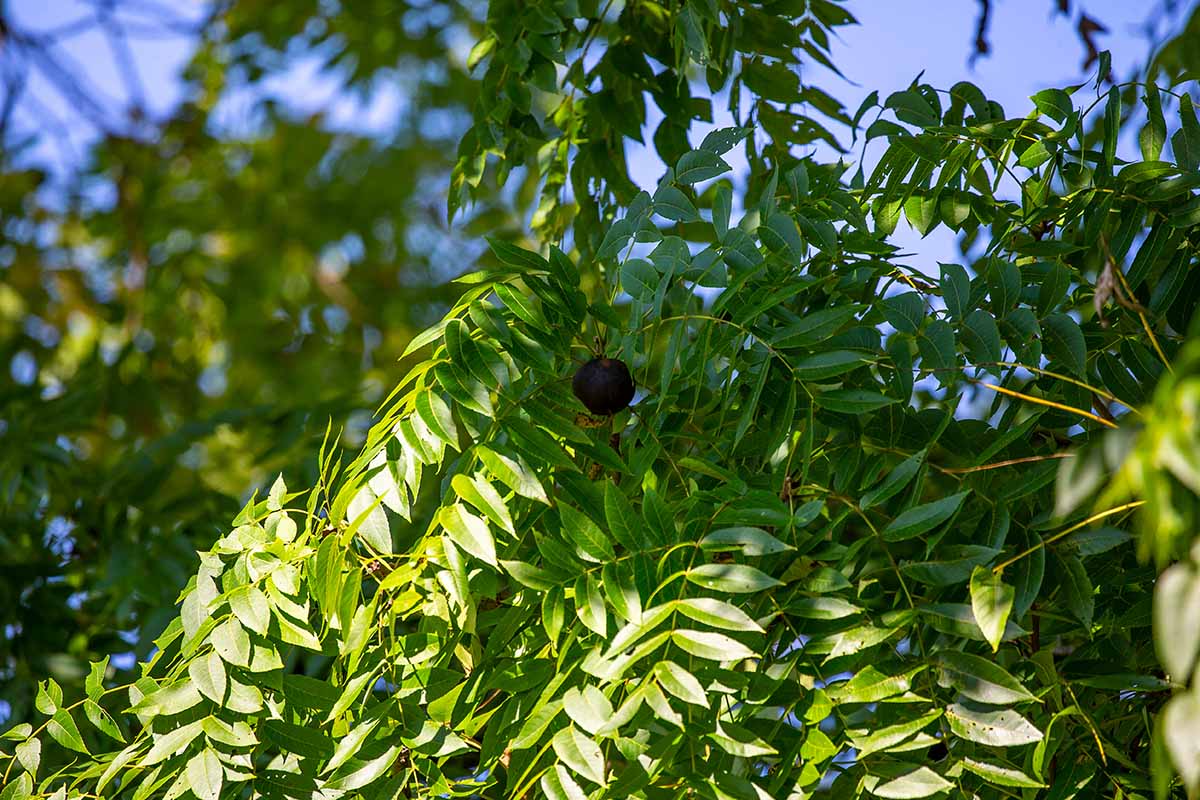
Settlers used its decay-resistant wood for everything from fence posts to shingles.
Of course, for thousands of years before that, native peoples such as the Cherokee and Chippewa were using this tree as a food source, a tonic against ringworm, and a dark dye for clothing.
Today, black walnut is highly valued in cabinetry and furniture-making for its dark heartwood.
So much so, in fact, that there are even stories of illegal “tree rustling” with large specimens simply disappearing in the night.
Black Walnut Propagation
Growing black walnut trees at home is a pretty easy affair. Here are some different ways to propagate plants:
From Seed
Growing J. nigra from seed is a simple, if messy, task.
To collect seed, try to find a nut which doesn’t appear to be split, chewed on, or damaged.
The nuts usually drop in early to mid-autumn and are a favorite of squirrels, so hop to it as soon as you notice them falling.

Gather your haul and remove the thick external hull. This can be done in numerous ways.
Some people like to use a very sharp knife to slice it off, others soak the nuts in boiling water for an hour then peel them, heck, others just drive the family car right over them.
But always, always pull on gloves first.
Remember juglone toxicity? Read more about that here.

Once you’ve freed your seed from the outer hull, place the hard, brown, wrinkly nuts one to two inches deep in moist potting soil in a standard half-gallon- to gallon-sized pot.
Black walnut seeds require a period of cold stratification to commence germination. The easiest way to do this is to cover your pots with rodent-proof netting and leave them outside for the winter.
See the below section titled From Seedlings/Transplanting to learn what to do once they emerge in spring!
From Cuttings
Although black walnuts can be grown from cuttings, it’s not the easiest way to get this tree growing at home. Cuttings are difficult to root and typically have a very poor survival rate.
If you want to give it a go, cut off a healthy foot-long section with four to five buds on it with a very sharp pair of pruners. Make sure you cut the section just above a bud.
Once you’ve got the cutting, snip the top bud, or apical meristem, off too.
Gently shave the bark off the bottom of the cutting, right up to the next bud. Dip this bottom portion in rooting hormone.
Bury the base in moist potting soil in a pot deep enough to bury the stem from its base up to that first bud.
Make sure the pot is at least four inches wide and can accommodate your cutting’s roots when they emerge. Cover with a plastic bag “tent” to ensure the cutting is kept moist.
Place in an area indoors with plenty of bright, indirect light. Check the soil regularly and water as needed so the soil never becomes dry.
With any luck, roots will start to form within eight weeks. Once this occurs, see the section on transplanting below to learn how to move your new baby black walnut to the garden!
From Seedlings/Transplanting
As always, the most failsafe way to get a black walnut growing at home is to buy a young tree at a nursery.
You’ll have to head to a reputable native plant nursery to find the straight species rather than a cultivar, but if you’re after this tree for its autumnal offerings, purchasing a cultivated variety might be the right move.
As with most other trees, spring and fall are the best times to transplant.
Once you’ve got your young tree picked out, or your seedling or rooted cutting is ready to transplant, site it in a location with deep, fertile soil if possible.
If not, that’s alright. You can stick it in almost anywhere and it won’t complain much, so long as it’s watered well.
Dig a hole as deep as your root ball and just a little bit wider so the top of the root ball is level with the ground. Fill in and water well.
Continue to water well and consistently during establishment and any dry spells.
Even young black walnuts can grow a taproot seven to eight feet long, so once happily settled in, trees can take care of themselves through some seriously rainless weather.
How to Grow Black Walnut Trees
As with any tree, site selection is important.
For a black walnut, this could mean the difference between a tree that grows three feet per year and produces copiously, versus one that inches along at a foot a year, bearing intermittently and infrequently.
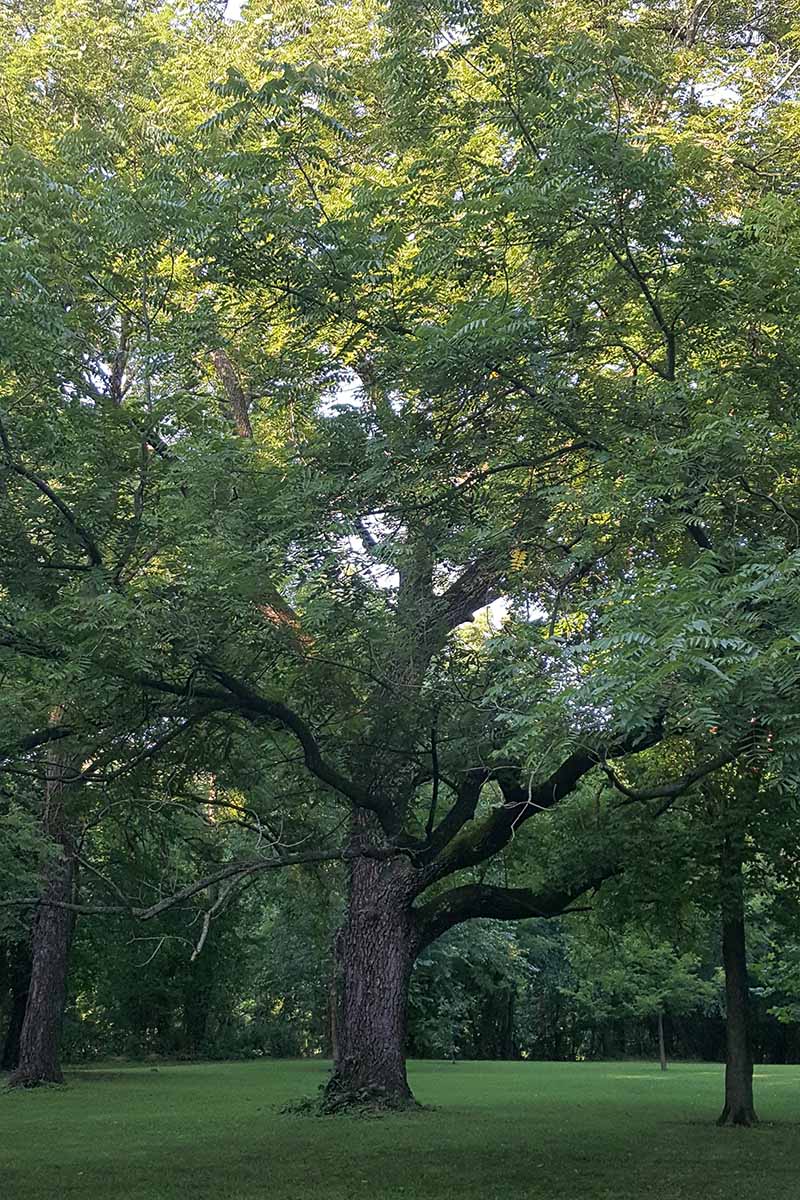
This native tree loves deep, sandy or silty loam and is not too particular about pH. Although it prefers to be consistently watered, it is both drought and flood tolerant.
J. nigra is endowed with an extensive root system, so it will find a way to grow wherever you wind up placing it, especially with a little extra care.
Make sure to plant in full sun as black walnut is shade intolerant.
As with any young treeling, make sure you water well at least once a week until it is established, and especially during dry spells. This usually takes a period of one to two years.

Although these trees are monoecious, meaning both male and female flowers are present on the same tree, the two different flowers mature at slightly different times as a way of reducing inbreeding.
If you don’t have any wild specimens growing in the area, it’s best to plant two.
If you need to top dress your plants with compost, particularly in dry locations with less than nutritious soils, do it in the spring and summer while the tree is actively growing and taking in nutrients.
Growing Tips
- Site in a sunny location in freely draining, deep, sandy loam if possible.
- Water once a week and particularly during dry spells.
- Top dress with compost in spring and summer if soil quality is poor.
- Plant two together to improve yields.
Pruning and Maintenance
As mentioned above, maintenance of black walnut is site specific, and largely dictated by how nutritious and moist its soil is.
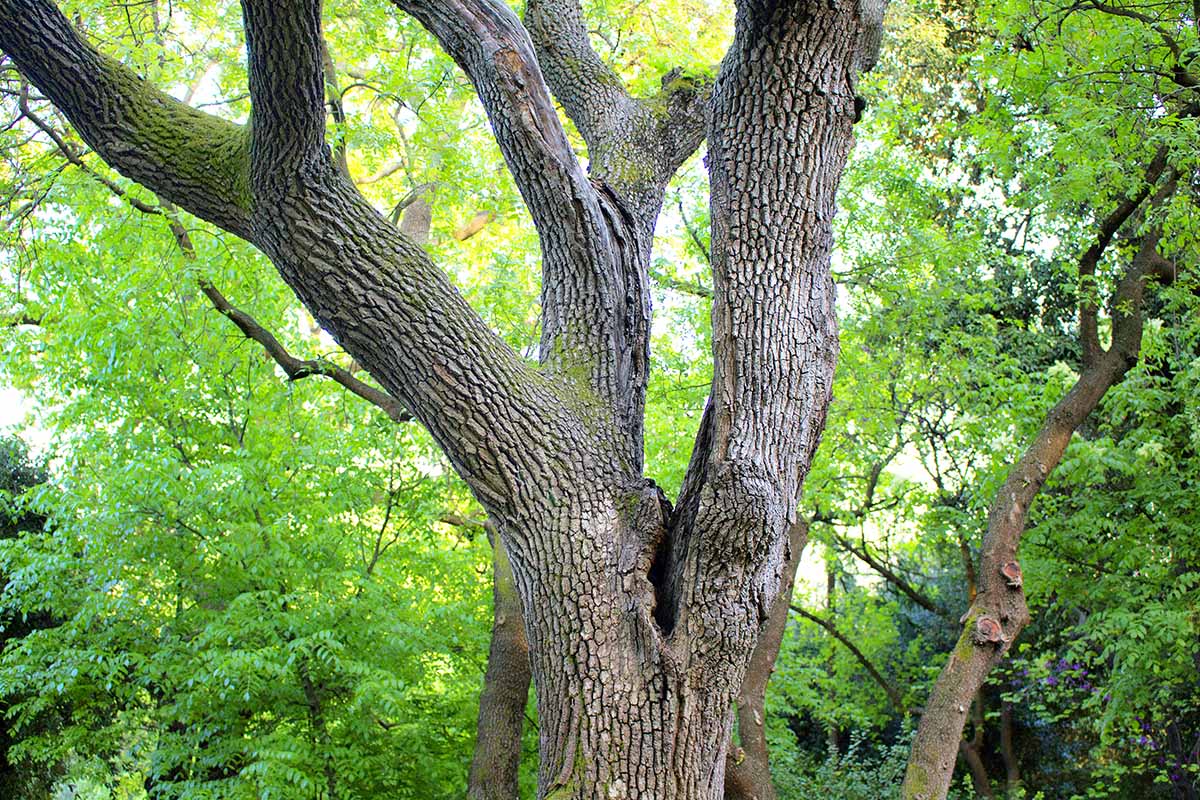
In the fertile, deep sandy loams it loves, it needs little TLC. In drier, less nutritious settings, it will benefit from a top dressing of compost and regular watering, especially during periods of drought.
There’s no need to prune your tree. In fact, J. nigra can sometimes get a little messy, dropping branches, in addition to nuts, that can get in the way of the lawnmower.
Beyond that, enjoy, and let this tree take care of you and your hungry belly instead!
Black Walnut Cultivars to Select
Interested in a species plant? Check local nurseries, or purchase one from Fast Growing Trees.
There are also hundreds of J. nigra cultivars available.
Based on characteristics such as pest tolerance, shell thickness, and nut production, there’s a plethora of options to consider. These are some of the most popular.
Black Gem
This variety produces prolific amounts of thin-shelled easier-to-peel walnuts. It’s heat tolerant, reaching heights of up to 60 feet, and as a bonus, is self-pollinating.
Hare
‘Hare’ produces a large, meaty nut and propagates well from cuttings. This variety is late blooming with high yields.
Rowher
Similar to ‘Hare,’ ‘Rowher’ produces a large nut with a good shell-to-nut ratio.
Sauber #1
This cultivar has the terrific quality of producing nuts which are easy to separate from their hulls.
Thomas
Lauded as one of the best-tasting nuts, this variety produces early in the season and is relatively easy to crack. The downside here is that it is not a consistent producer.
Managing Pests and Disease
As with most native plants, there isn’t much that truly plagues black walnut.
Below, we’ll detail a few of the more serious pests and diseases that can have an impact on this otherwise tenacious tree.
Herbivores
Thanks to juglone, which is present in large quantities in black walnut’s buds, almost no one dares to nibble on this tree’s handsome foliage.
Chipmunks and Squirrels
Chipmunks and squirrels, although considered seed predators, are actually some of nature’s best gardeners.
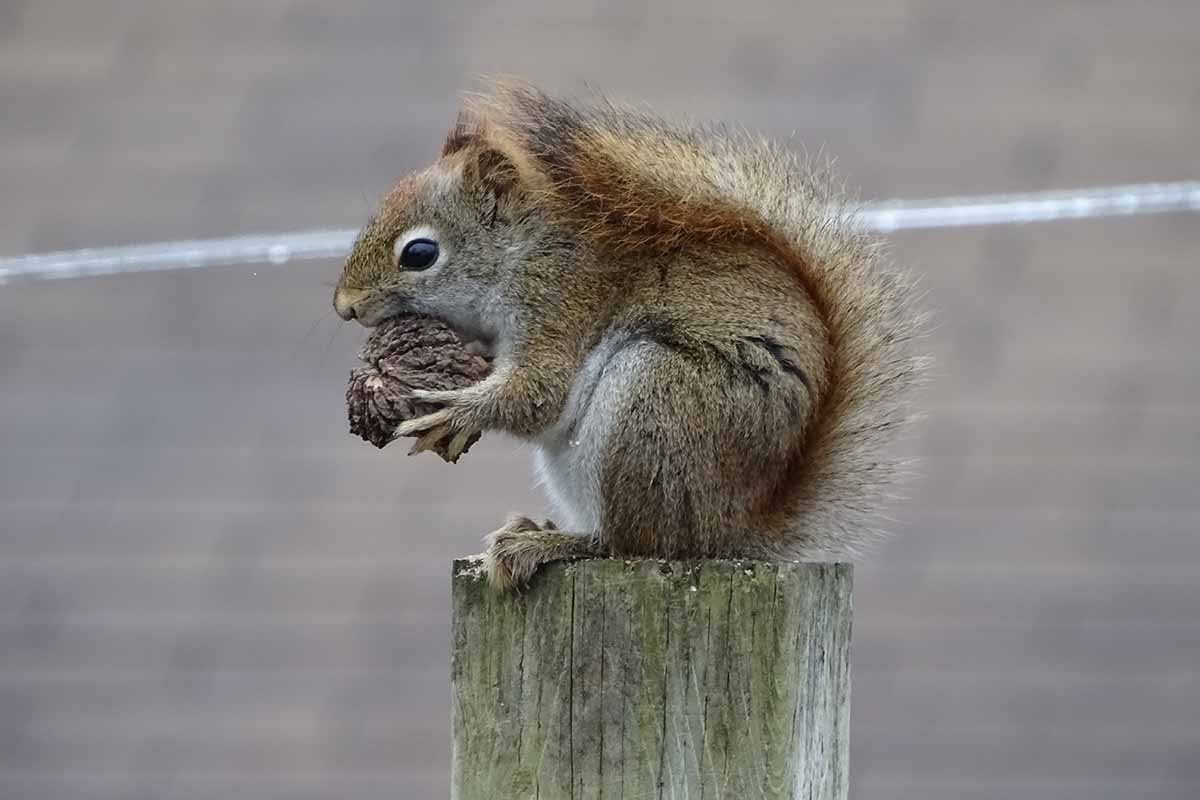
After all, what do you think happens to those forgotten nuts carefully cached beneath the soil?
But for you and your black walnut, consider these squirrely critters a formidable force that stands between you and your autumn haul.
Insects
J. nigra is happily adapted to manage the nibbling of most insects, and in fact, many native creepy-crawlies depend on this tree for food.
There are only a handful which can cause real damage and weaken or wound the tree.
Ambrosia Beetles
This type of hard-shelled beetle prefers to target young black walnut trees and is not typically a problem if trees are kept well watered, weeded, and in generally good health.
If growing black walnut as a timber tree, the ambrosia beetle can wreak havoc as it primarily tunnels inside the wood, creating squiggly galleries under the bark.
Additionally, its chewing may introduce a fungus that can stain the wood and cause thousand cankers disease (TCD).
Aphids
Aphids do little damage to healthy trees, but occasionally a large outbreak can occur and cause shoot dieback. This can ultimately affect yields.
To manage aphids, spray young trees with a strong jet of water daily. This will dislodge most of the pests.
Caterpillars
This dark-colored, fuzzy, native caterpillar, Datana integerrima, is capable of defoliating fair-sized trees.

Fortunately, it also feeds on other members of the walnut family, and devastating outbreaks outside of walnut plantations are fairly unusual.
The adult form is a pale brown moth with a ruddy red head.
Curculios
The walnut curculio, Conotrachelus retentus, is a cute little weevil with a destructive bent. The larvae feed within the nut, causing it to drop prematurely.
Some evidence suggests that mowing around the base of the tree may be disruptive to the life cycle of this pest.
Shoot Moths
Walnut shoot moths, Acrobasis demontella, lay eggs on the underside of leaves.
The larvae, once hatched, feed on leaves and buds, and eventually burrow into the new growth itself, causing shoot dieback.
Twig Beetles
Walnut twig beetles, Pityophthorus juglandis, are another kind of beetle that loves to chew on the soft tissue of J. nigra.
Although the larvae and adults can cause localized damage, it is actually the introduction of the fungus which causes thousand cankers disease that can wreak havoc on your tree.
Thus far, these twig beetles are primarily found in the western states. But as the climate changes, they are rapidly increasing their range.
Disease
Largely resistant to disease, there are a few culprits that can cause unsightly cankers and other symptoms.
Fusarium Canker
Typically occurring after a heavy rain, fusarium canker causes large fissures in the bark.
This fungus is introduced to the tree by a number of different insects, including weevils.
Growing over time, fusarium cankers cause cracks that wound the tree and prevent it from effectively transporting nutrients.
This results in lower nut yields and eventually can lead to death.
You can prune away branches visibly affected by fusarium canker but make sure to sterilize your pruners after each use to avoid spreading the fungus to other trees.
Leaf Spot
Leaf spot, also referred to as walnut black spot or anthracnose, is caused by a common fungus, Ophiognomonia leptostyla (formerly Gnomonia leptostyla).
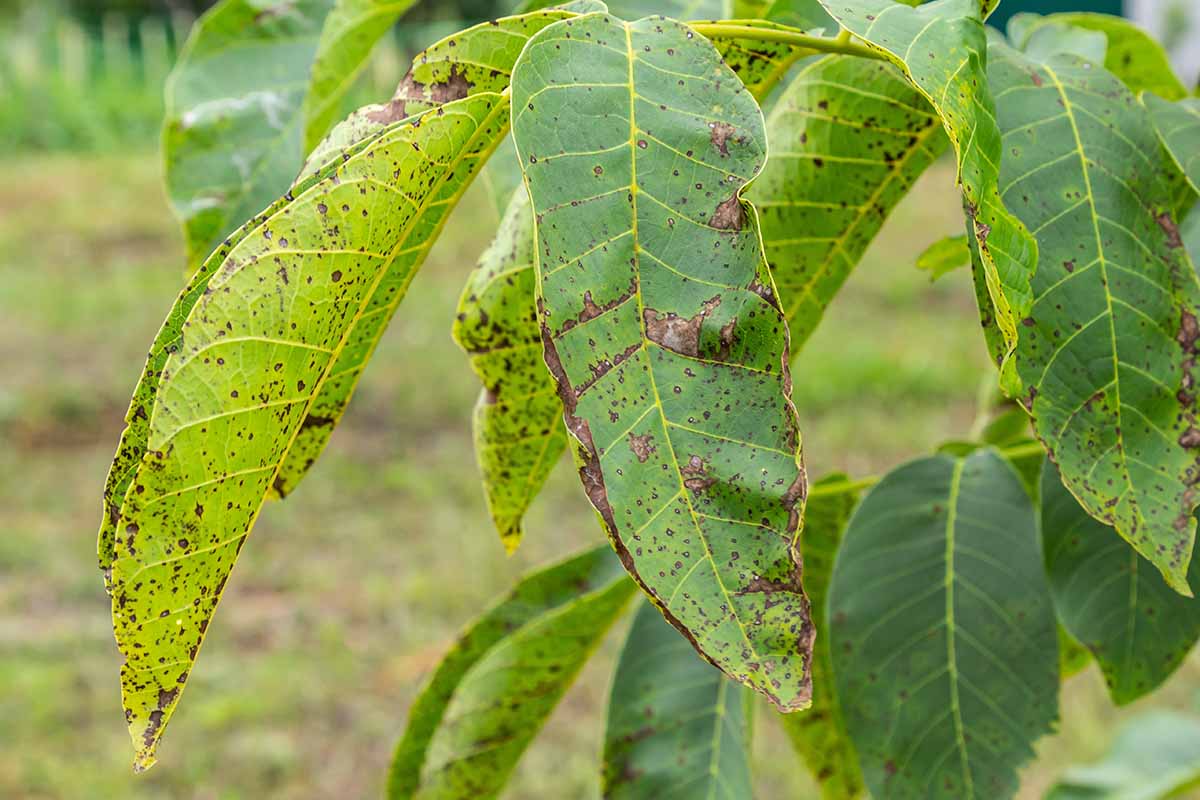
Black walnut is particularly susceptible to this widespread but not seriously damaging fungus.
Typically, leaf spot begins as small black to brown spots on, you guessed, it the leaves. It causes early leaf drop, and little else.
To slow the spread, clean up affected leaves in the fall and burn them instead of composting.
Maintain good soil fertility and make sure to water the tree when it needs it. A healthy tree has the best natural defenses against all common pathogens.
Nectria Canker
Although not commonly fatal, the cankers caused by this fungus, Nectria galligena, can kill new growth and branches, and certainly compromise crop yields.
The cankers typically appear as discolored, sunken areas. When the reddish fruiting bodies appear, the tree often responds by growing large, bulky calluses around them.
Plants that are stressed are more seriously affected by this disease, so make sure to top dress with compost and water plants when they need it to ensure they stay healthy.
Thousand Cankers Disease
A common condition potentially fatal to a whole slew of species, thousand cankers disease is caused by the fungus Geosmithia morbida.
his fungus is introduced by the activity of the walnut twig beetle and causes numerous, oval-shaped, dark cankers which inhibit the tree’s ability to transport water and nutrients effectively.
Thousand cankers disease is often fatal to affected trees.
Best Uses of Black Walnut Trees
Multifarious in its uses, the best way to enjoy black walnut is the one that works for you.
Need an expansive shade tree? Want to attract endemic insects? Got a woodworking hobby? Or do you just want a big slice of native walnut pie?
Hey, you could even plant a few of these guys as inheritance for your grandchildren.
Harvesting Black Walnuts
Collect black walnuts once they start to drop from the tree, usually towards the end of fall.
You can pick them up promptly if you need to mow the grass under the tree but typically, leaving the nuts to soften on the ground for a week or two makes hull removal easier.
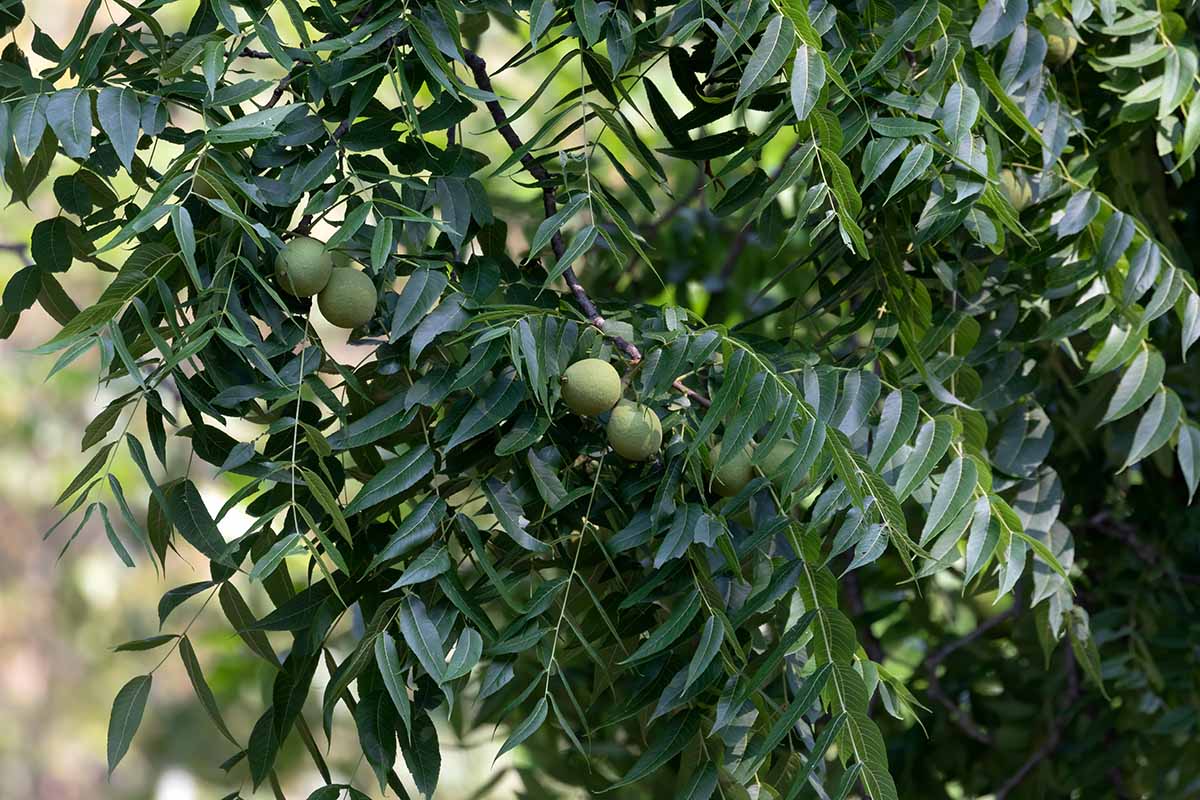
Before you harvest make sure you’re wearing gloves to protect your skin from juglone, and old shoes you don’t mind getting stained with the inky brown pigment.
Collect the nuts in a washable container or something that can get stained, too.
To remove the hulls take the nuts to a hard surface like the road or a paved driveway.
Now is the time to get creative and let it rip. Stamp on them, break out a hammer, or even drive the car over them!
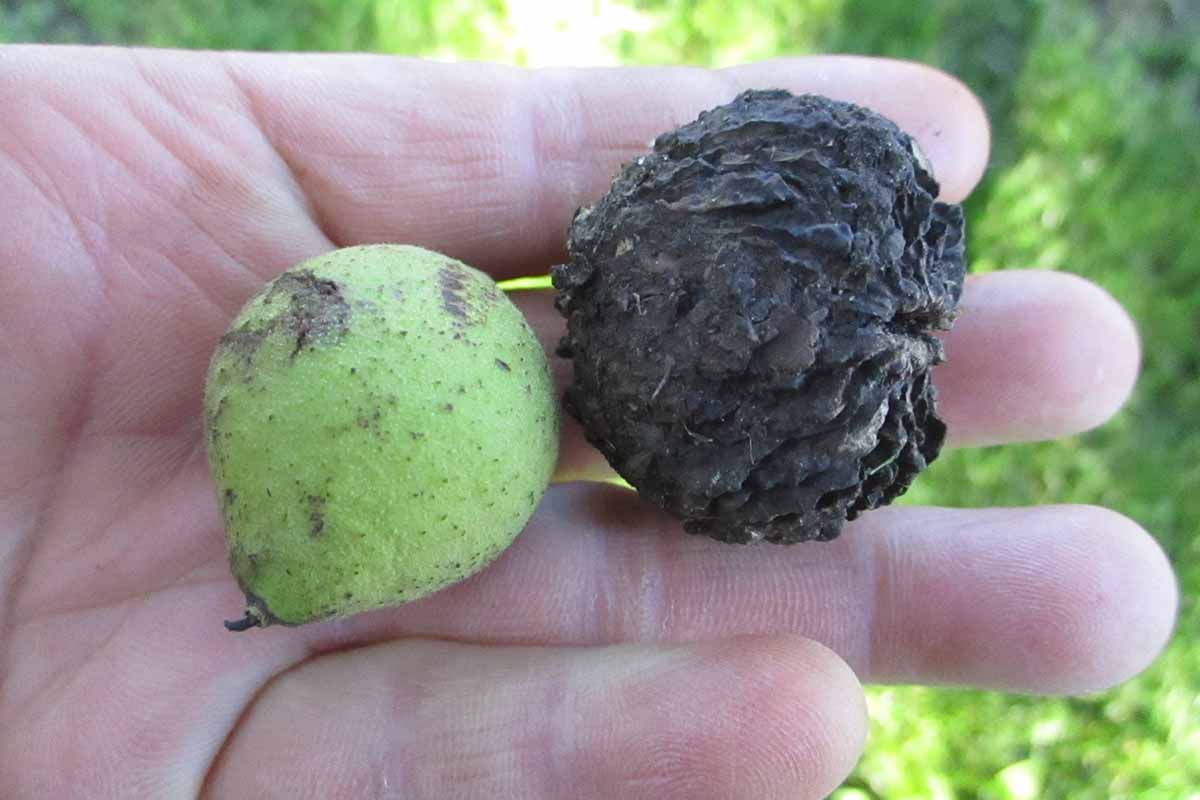
Once the hulls are removed put them all in a bucket and hose off any husk maggots and extra pieces of hull-flesh.
The maggots won’t damage the meat so don’t worry about that, but do remove any nuts that float as these are rotten or withered inside.
Once rinsed and clean, bring the nuts into a well ventilated area, such as a screened-in porch, to dry for two weeks.
Preserving Black Walnuts
Once cleaned and cured, black walnuts can be stored for up to year in an airtight container.
Prior to storage, you’ll want to freeze your bounty for 48 hours to ensure any maggots or insect eggs inside the nut are killed.
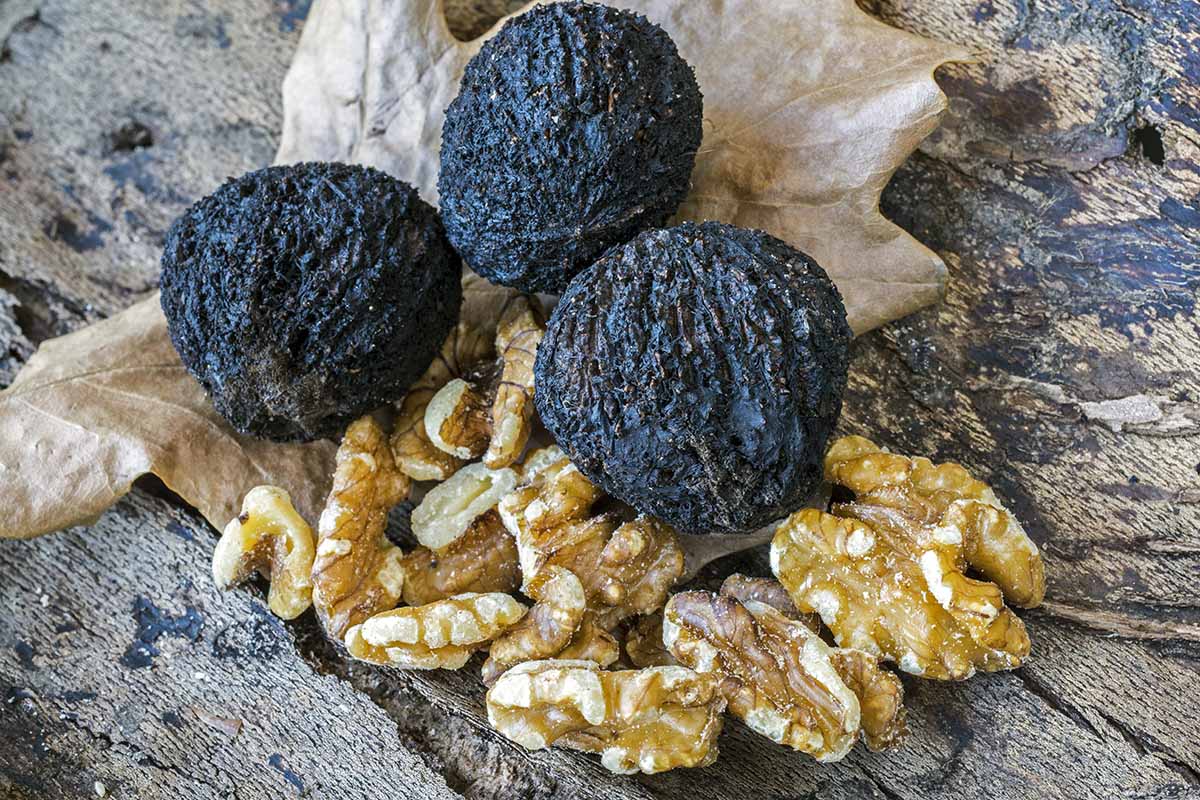
Generally speaking, they last longer when stored inside their shell.
You can keep a ziplock bag of walnuts with their shells still on in the fridge for about six months, or in the freezer for a year. If unshelled, they’ll go rancid within three months.
Make sure to always label your storage container with the date the nuts were harvested.
Recipes and Cooking Ideas
You can use these nuts for anything you’d use regular walnuts for, although the black walnut has a stronger, earthier taste.
The internet is chockablock full of sweet recipes that include black walnuts from pound cakes to cookies to ice cream.
To enjoy any of these culinary concoctions you must of course crack the nuts open.
This isn’t that hard and can be accomplished with a hammer and a hard surface, but it can get quite tedious if you need enough nuts for, let’s say, a pie.
Personally I think the best way to eat them is with the aid of a good nut cracker, some picking fingers, a good bit of patience, and nothing else.
Quick Reference Growing Guide
| Plant Type: | Nut tree | Flower/Foliage Color: | Green/green (yellow in fall) |
| Native to: | Eastern North America | Water Needs: | Low |
| Hardiness (USDA Zones): | 4-9 | Maintenance: | Low |
| Bloom Time/Season: | September-October (nuts) | Tolerance: | Clay, lean soil, moderate drought, occasional flooding, silty soil |
| Exposure: | Full sun to part shade | Soil Type: | Deep, rich, sandy loam |
| Time to Maturity: | 12-15 years (nut production) | Soil pH: | 5.0-8.0 |
| Spacing: | 40-80 feet | Soil Drainage: | Well-draining |
| Planting Depth: | 1-2 inches (seed), depth of root ball (transplants) | Attracts: | Moths and butterflies including banded hairstreak, regal moth, luna moth |
| Height: | Up to 100 feet | Uses: | Food crop, lumber, furniture making, medicinal |
| Spread: | Up to 75 feet wide | Family: | Juglandaceae |
| Growth Rate: | 1-3 feet per year | Genus: | Juglans |
| Common Pests and Disease: | Ambrosia beetles, aphids, fall webworms, flatheaded apple tree borers, plant lice, walnut caterpillars, walnut curculios, walnut lace bugs, walnut shoot moths, walnut twig beetles; fusarium canker, leaf spot, nectria canker, thousand cankers disease. | Species: | Nigra |
All It’s Cracked Up to Be
Versatile and forgiving, black walnut can cope with a multitude of environmental conditions. But remember, the better you treat it, the better it will treat you.

Water your tree when needed and help it to become well established. Ensuring good health in the beginning will ensure better crop yields and disease resistance.
Endowed with juglone, a powerful toxin, take time to read up on what will thrive beneath black walnut, and what will wilt. Careful consideration will result in a happier home garden ecosystem.
What do you have growing beneath your black walnut? How did your last harvest go? Questions and comments are always welcome!
To learn more about growing native nut trees at home, check out the following guides:
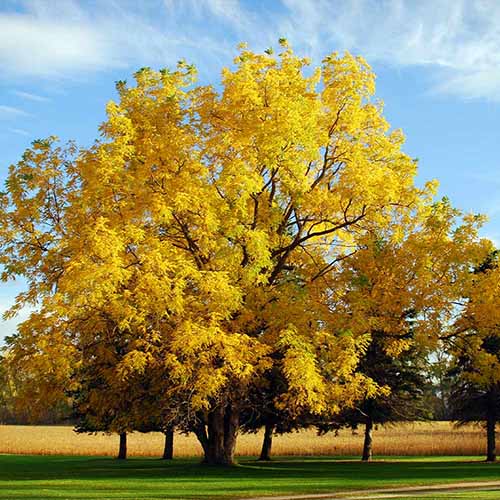
My dear Mother gave me a black walnut tree when I bought my house, native to Ontario, this tree towers over my backyard since I planted it in 1989. Beautiful stately specimen that will remain long after I’m gone.